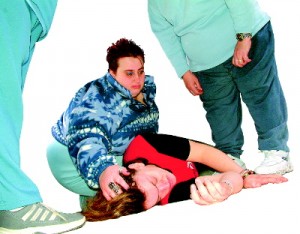A lot of people panic at the sight of an unconscious victim. If you have seen an unconscious person, you can do simple things to help him or her. Loss of consciousness results from the interruption of the normal brain activity, and can happen gradually or suddenly. It can arise due to certain medical conditions or injuries as well as side effects of medications or chemicals. Depending on the severity of the condition, the unconscious person may still 
Regardless of the severity or cause of unconsciousness, the immediate first aid is the same:
- Check the victim’s consciousness by gently tapping or squeezing the shoulders and asking if he is alright.
- Lift up the chin to open the airway. Clear the mouth of any obstruction and keep airway open.
- Check and monitor breathing. Be ready to resuscitate if necessary.
- If breathing, proceed with checking other possible injuries and place in recovery position.
- Call 911 or your local emergency services.
These are helpful first aid techniques you can do while waiting for emergency help to arrive. If you have more time, you can gather information that can help the rescue service in diagnosing and treating the victim.
Assessing level of consciousness
Rescue services, as well as other healthcare professionals, use a standard scale for grading the responsiveness of an injured person, known as Glasgow Coma Scale (for a brief history click here). A fully conscious and coherent person is given a score of 15 while a person who is unresponsive is given 3. You can help gather information which is vital for the medical staff. To use this simplified version of the Glasgow Coma Scale, simply rate the person’s best response to these three criteria and get the total.
|
Glasgow Coma Scale |
||
| Eye Opening | Response | Score |
| Opens spontaneously | 4 | |
| Opens on verbal command | 3 | |
| Opens in response to pain | 2 | |
| No eye opening | 1 | |
| Verbal Response | Oriented to time, place and person | 5 |
| Confused conversation – responds but with some degree of disorientation or confusion | 4 | |
| Inappropriate response – exclamatory or random words, no real conversation | 3 | |
| Incomprehensible speech – moaning or only sounds | 2 | |
| No verbal response | 1 | |
| Motor response | Obeys command of simple tasks | 6 |
| Localizes pain | 5 | |
| Withdraws limb from pain | 4 | |
| Flexes limbs in response to pain | 3 | |
| Extends limbs in response to pain | 2 | |
| No response to pain | 1 |
Repeat your assessment every 10 minutes and keep a record. Continue monitoring breathing and pulse.
Some people may experience a brief loss of consciousness or fainting episode. Usually, fainting is caused by shock or low blood pressure but can also be due to intense reaction to a stressful event, lack of food or prolonged inactivity.
To treat a person who has fainted, lay him on his back with the legs raised slightly higher than the heart. Open the airway and check for breathing. This ensures proper oxygen to the brain and hastens recovery period. However, if the victim does not regain consciousness after 3 minutes, or if the victim experiences difficulty of breathing, place him on the recovery position. To learn more about effectively managing unconscious victims in a variety of scenarios enrol in workplace approved first aid training with one of our credible and popular providers.
